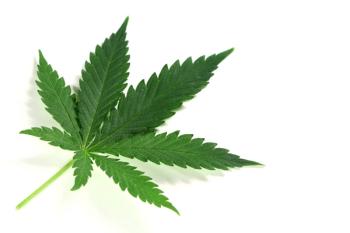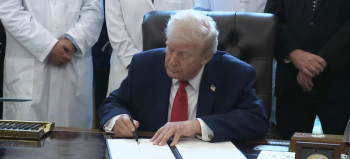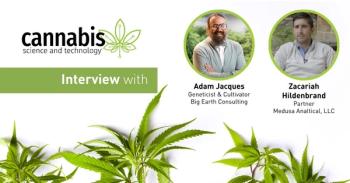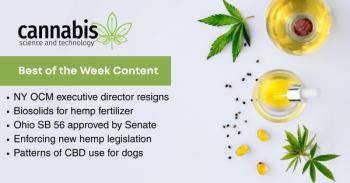
Chronic Pain Research Endeavors: How an App and University Are Presenting Real-World Patient Data
One of the recurring challenges in the medical cannabis space is the difficulty in conducting research because of the plant’s Schedule I status. Although there are some researchers diving in with special licenses to conduct clinical studies, there are others that are looking at real-world users to supply data. For instance, Dr. Daniel J. Kruger is a Research Investigator with the Population Study Center at the University of Michigan and Principal Investigator on a study being conducted with the Releaf app. Here, Dr. Kruger shares his interest and background in these types of surveys and his plans for the current study with Releaf on chronic pain.
Can you tell us more about your background areas of study and how you got involved in cannabis studies?
Dr. Daniel J. Kruger: I have a broad academic background, my training ranges from evolutionary biology to very applied community research. Some of my research is very theoretical, using evolutionary biology to understand human psychology and behavior. At the other end of the spectrum, it's very applied: I’m trying to understand health patterns in communities and ways to improve them. As part of the latter research, I attend and present in public health conferences, and other venues where people are working in health and healthcare.
Public health conferences would feature presentations on cannabis, but all the presentations were from the framework of the Prohibition Era. It was all about abstinence-based programs, getting people to quit if they're using cannabis, all the possible harmful effects, which is a valid area of study, but also the so-called gateway drug fallacy: basically, if people are using cannabis, that's going to lead them into harder drug use. So, after seeing presentation after presentation repeating these themes, I would talk to the presenters and I would say, “Okay, now California and other states have legalized access to cannabis for people who want to use it for medical purposes. So, what's the public health framework for that?” And there really weren't any answers. I mean, people were stunned. It was sort of like deer in the headlights. If they said anything, they would say, “well, we don't think that's a good idea,” or “that's too risky.” After a while, it occurred to me that public health is really not prepared for this change.
A lot of the changes in the cannabis landscape were driven by ballot initiatives and grassroots legislation. But, transitioning from a world where cannabis is an illicit substance, and you're just thinking about it in a criminal model, to the medicalization of cannabis, there's so many things that you want to know. Just imagine all the things that it takes to bring a pharmaceutical drug to market. All these different phases of clinical trials. You have to test for dosage, safety, risks, and so forth. Unfortunately, because it was just prohibited for so long this research hadn't been done.
So, it's sort of like public health is standing on the train tracks and there's this freight train of legalized cannabis coming down the tracks and it's just going to get run over because millions and millions, in fact, now the majority of people in the United States, have legal access to cannabis, both for medical and even recreational use. They don't even need a medical card.
There's a lot of research and education that needs to come along with that for us to fulfill the proper mission of public health. And that's really to keep people healthy and to maximize the health benefits, and to minimize the costs, risks, and harms of any kind of medication or substance that people are using. And at the time, a decade ago, the kind of research that would support that was few and far between. So, like George Washington getting called into action, somebody has to do this work and I guess it's us. It wasn't really an area that we had trained in, there was no training available at the time. So my partner and I started research collaborations investigating naturalistic cannabis use and how people were using it to treat all sorts of different health or medical conditions: what they knew about it, what they didn't know, what harm reduction techniques they were using. I'm pleased to say that now there's a boom in cannabis research just like there is in the cannabis industry. It’s a very different landscape than it was 10 years ago, but there are still many, many questions to be answered.
So, 10 years ago when you started this research, what kind of challenges did you face? Was it hard to get people to be honest in the kind of questions you were asking them, or even just to get the research approved?
Dr. Kruger: I don't think that people were as concerned, because we had a little bit of an outside the box thinking in terms of our initial studies. One of the challenges when we're thinking about this is, well, how are we going to survey people who are using cannabis, which at the time was technically illegal. How are you going to advertise for a study or gather people or get them to respond even to an online survey?
Fortunately, being at the University of Michigan in Ann Arbor, the people come to us because there's an annual event called Hash Bash that started originally as a protest when John Sinclair, who's a musician, poet, and activist was arrested for giving away, not selling, but giving away two joints to an undercover agent. This happened in the early 1970s. At the time, cannabis use was really prevalent—I don't think the police were really even arresting people for it so much then. But Sinclair was a troublemaker for the powers that be. He was an activist and they wanted to get rid of him, so this is how they were going to do it. Because at the time, the laws in Michigan were still very strict. So technically, he committed this crime that they could sentence him to 10 years in jail, so they did and then there was a big protest about it.
In fact, John Lennon and Yoko Ono came as well as many other musicians, and they filled up the Crisler Center arena, which is where they play hockey and basketball at the University of Michigan. There was this big protest, but coincidentally, a federal judge also reviewed the case and said, “Now this is ridiculous, you can't sentence someone to 10 years in prison for having two joints.” So, he threw the case out and then technically there were no anti-cannabis laws on the books in the state of Michigan. There was this legal opening and people threw a celebration that became the first Hash Bash when technically it was not illegal because the law of criminalizing it had been thrown out. Of course, the Michigan legislature quickly responded and recriminalized it. But this started a tradition where thousands and thousands of cannabis enthusiasts come to Ann Arbor and have a rally and celebration right in the heart of campus, right on what we call “The Diag,” which is like the quad in front of the big, beautiful library. You have guest speakers and there's thousands of people.
Well, we thought this was the perfect opportunity to do a survey there, having a lot of experience in the survey world. In fact, when I was training, I even interned as a door-to-door survey researcher in Chicago on a National Institute on Drug Abuse (NIDA) drug use study. So that gave me some real practical lessons in the best practices for conducting a survey like this. We actually had a team of students and at the time—we were still really concerned about this. It was the first time that we had done this or anyone had ever thought about doing something like this. It was a team of faculty and graduate students; we thought graduate students would be more mature and better able to handle anything that would happen than undergraduates. It went really smoothly and we went out there and we had colorful displays and people wore costumes to be more relatable to the potential participants.
It was a great success. We were able to collect, I believe, more than 300 surveys and thus document naturalistic cannabis use and how people were using it and what their concerns were. Then after that, I thought, I can't believe that nobody else had thought about this before because it really was a great opportunity. You really had to know how to do it appropriately. Long story short, we couldn't come in there with a typical psychological survey instrument that takes 30 to 45 minutes to complete and such. We knew that we only had a short amount of time to get to get people's input.
We continued to do that every year and then our studies were eventually published. Then when we made it into the news, we were contacted by a local dispensary in Ann Arbor, whose staff at the time had a very idealistic vision for what they wanted their dispensary to be. They really did want to follow best practices and be informed by research and be good for consumers. Not just a profit-making business, but something that really did have the best interests of their clients in mind. So, I partnered with them and then through them met other researchers who had a similar mind set and were surprisingly also at the University of Michigan, but miles away in a different part of campus.
We’ve continued to collaborate since. So, it's nice that there's a growing research community at the University of Michigan, looking at cannabis and taking it seriously. Well, what does it mean to take it seriously? If we were to take the medical use of cannabis seriously, what would that look like and how should we do it?
What made you decide to work as the principal investigator with the Releaf app in your current study related to chronic pain?
Dr. Kruger: There are a lot of different components to that. One is pain, which is one of the main conditions that people use medical cannabis to treat. We found that in our studies, and other people have found it in their studies as well, pain is consistently one of the most common conditions that that people are treating.
The National Academies of Science, Engineering, and Medicine, basically, the United States’ official scientific body and authority, issued a
There's also the technical element of the Releaf app as a data collection platform. It can conduct what we call ecological momentary assessments (EMA), which ping people at specific times of the day, or even random times if the study wants that, to fill out a brief survey on their phone. So, it's a mechanism for data collection, or platform for data collection. The larger picture is that this sort of cross-sector collaboration enables the kind of research that needs to be done that would be difficult to do otherwise, because right now, cannabis is still illegal at the federal level. It's still a Schedule I substance. So, if we were to do a study where we wanted to give cannabis products to people and then assess their efficacy for treating chronic pain or anything else, we'd have to get a Schedule I license from the Food and Drug Administration (FDA). Those are incredibly difficult to do. There are some people that do it, but it's a very difficult, cumbersome, and lengthy process of setting up such a study.
By collaborating, we can investigate naturalistic cannabis use, or basically people who are self-medicating. We can survey them and ask them about their experiences, and if they're doing it systematically, it's fairly equivalent to a clinical trial. If there are standards and procedures that are followed and it’s putting the components together in a way that makes this kind of work feasible, or much more feasible, given the current restrictions. So, it’s pretty ideal.
Another reason why this kind of partnership is ideal is because, you have both industry—people who are working in this field—and academics working together. There’s often very different perspectives that they bring to the table, but one aspect that academics bring is independence. In other words, we can use solid science and follow the data. We’re not so much tied to what the results of a particular study are. Not necessarily the partners we’re working with now, but certainly some people in industry would feel pressure to have positive results. Some might even fudge or fake data to show those positive results even if they’re not there. But if you have academics who are outside and independent and the outcome of this study really isn’t going to affect my career, it’s nice to have that independence where you can objectively assess the data and say these are the results.
I think that builds trust, especially in an area like this that’s sort of sensitive. I think that’s one big component of value that this kind of partnership brings to the table. I actually consulted in other industries where there was some internal evaluation staff and they’re basically cherry-picking evaluation results because they want it to show that their program worked. I said to them, “listen, here are the results, this is the way I wrote it up, and I wrote it up in a way to try to be clear and informative, and don’t change it. Don’t edit it.” They really struggled with that and I think that's one reason why I'm not working with them any longer, because I wouldn't let them bend the data to their interests.
These are results, and honestly, you really do want to be informed by honest, accurate information for someone who has a dispassionate interest. We really want to seek the truth. Ideally, that's what academics do.
Can you tell us more about the chronic pain study and how it was designed? What types of pain you're looking at?
Dr. Kruger: We're looking at individuals who have different types of chronic pain conditions such as fibromyalgia, rheumatoid arthritis, and osteoarthritis of the knee or hip. To make a long story short, these conditions have somewhat different mechanisms biologically, maybe even psychologically. So, it's interesting to study them together and to see how effective cannabis is at relieving pain because they might operate with somewhat different mechanisms in the body. Also, we are studying how different types of chemical compositions of cannabis could be more or less effective at treating each one of those.
That's important because cannabis is very complex in terms of all the different compounds in it. It's not like alcohol. Alcohol is just one substance, ethyl alcohol and we have a pretty good understanding of its effects. But with cannabis, there's hundreds of different cannabinoids, as well as terpenes and other components that people are now investigating, things like the entourage effect. Is there any truth to this notion that there's a synergistic effect between all these different compounds? That's a good question.
Many people know about tetrahydrocannabinol (THC), and cannabidiol (CBD). These are probably the two most well-known cannabinoids, but there are hundreds more that we know very little about. Imagine if you went to a pharmacy and they gave you a bunch of different looking pills in unlabeled bottles and said, “just take these pills until you feel better.” It's not very systematic. That's the picture with cannabis right now.
There's a lot of research going on, but we really do need to answer these questions. What are all the different effects of all these cannabinoids separately and how do they work together? What are the appropriate dosages? Is there individual variation in what the appropriate dosage is?
There are all these questions that you really want to answer to maximize the effectiveness beyond just the statement that cannabis is effective for treating chronic pain. That's just the start. That’s really our call to action to see how we really can maximize the benefits and minimize the cost, risks, and harms for people who are using cannabis to treat chronic pain conditions.
How do people enroll? Is it still ongoing or has the study ended?
Dr. Kruger: Enrollment is currently open. Interested individuals can learn more about this study and enroll by visiting
What do you hope to learn from the chronic pain study, and when do you plan on having results published?
Dr. Kruger: There are two major components to this: 1. The different cannabinoid compositions and how effective those are; and 2. The different types of pain. We might even see an interaction where there are certain types of pain that certain compositions are more effective for. Then other compositions are more effective for other types of pain. Those are some of the basic questions that we're looking to answer. The data collection was launched in August 2022. We're hoping to complete data collection in late fall 2022. Then we'll be working on our data analysis and writing up reports, and then we will submit at least one manuscript to a peer-reviewed journal. That again puts our research through another process of scientific scrutiny, where independent researchers and scholars will look at our study to see if there are limitations? Can we justify the conclusions that we're presenting? We think we have a solid study and given the National Academies’ determination and other evidence that we've seen from the field, we're expecting to see interesting results. We're looking forward to writing up that manuscript and submitting it, and then it will go through a peer review process to see how trustworthy this information is.
Sometimes that does take months because you will likely have to revise your manuscript sometimes more than once. But hopefully we'll have an article out by the middle of next year. Then certainly anyone, anyone who participated in the study, can contact us and we'll share the results with them.
You also conducted a study in 2019 to find out how knowledgeable a sample of cannabis consumers were in regard to the effective levels of THC and CBD and dosing. Why was it important to gather and study this kind of information and what were the outcomes?
Dr. Kruger: This really gets at some of the major issues regarding the gap between the medicinal use of cannabis and what you would expect best practices to be. As well as the gap with mainstream medicine. We found that most of our participants use cannabis every day and the vast majority, 85%, use cannabis to treat a health or medical condition. That's significant. People might consider recreational use something different. Maybe they wouldn't take it as seriously. But if people are using it medically, using it to treat a health or medical condition, you really want to know what the best practices are, especially regarding something like dosage.
However, people's knowledge about cannabis was mostly from their own experiences. Maybe about a fifth of them got information from a medical cannabis caregiver or dispensary, the place where they were getting their cannabis from. That would be expected, but fewer get any from their primary healthcare provider. That’s less than one-fifth. That's really striking and remarkable. In fact, many of them said that their primary health care provider didn't even know that they were using cannabis to treat their health or medical condition. For us, that raises serious issues, if there's a disconnect between their medicinal cannabis use and the healthcare system.
Maybe people aren't revealing it because they're concerned about the legality in their state or maybe they have employment concerns like, “what if my job finds out that I'm using cannabis?” It's a very real issue as to why people might not be disclosing to their primary healthcare provider. At the same time, that does create additional issues or concerns. One of these concerns is that to what extent do people really know what they're doing. So, we asked, “What do you think an effective dose of THC is? What do you think an effective dose of CBD is?”
There are also some questions to be answered. For example, are there different dosages for different conditions? That's something that hopefully, we'll find out in our research and future research. But as of now, there are a number of different bodies that have defined dosages for THC and CBD. For THC, that's typically, 5 milligrams or 10 milligrams. For research purposes, 5 milligrams has been defined as the standard unit. California, other states, and other areas have defined 10 milligrams of THC as a standard dose. So, if you're buying an edible, they'll say, okay, here's a chocolate bar, and it has 10 pieces. Each of them has 10 milligrams, so it's 10 doses. It's really good to inform people about how much you need to take. But the majority of our participants had no idea what an effective dose of THC was. Even those who did gave estimates that averaged 91 milligrams. That's about nine times what the guidelines would recommend. Honestly, this is one of the legitimate concerns you have with cannabis. People might overconsume an edible because they don't know how much to take. They might see one cookie or one brownie and just eat the whole thing and then literally might end up in the hospital because they're having a panic attack.
That's something that people really need to be educated on—and the same with CBD. There's less research into dosages of CBD, but still the majority in our 2019 study had no idea what the dosages were and said that the appropriate amount would be 177 milligrams. So again, that's several times what you would typically find, say, in a gummy or a capsule that has maybe 25 milligrams of CBD.
There were also estimates for how much THC and CBD would be in strains of cannabis flower, basically, the raw bud that people might smoke or vape. Their estimates were way higher than in reality. They thought that the average THC content in cannabis flower was 52% and that's far beyond what even the highest THC strains have right now. This is the same for CBD. Long story short, they grossly overestimate how much THC is necessary, how much CBD is necessary. That's a concern and something that we really should address with education and more research.
What has surprised you most from your research with cannabis?
Dr. Kruger: I think those findings show how far we are from where we need to be. Imagine an ideal system where cannabis is treated seriously as a medicine and is fully integrated with people's medical treatment. All those different aspects we would need to have, including patient education.
It’s apparent to us from our research that we're still pretty far away. Honestly, I think the Schedule I status is probably still a major barrier for this to be fully realized for legal concerns, constraints on research, and other aspects. So hopefully, that will shift in the future, especially now that a majority of the American population, as I said, have legal access to not just medical, but recreational cannabis.
Where do you recommend people go to find information on similar studies, current or past studies, and research on cannabis usage?
Dr. Kruger: Google Scholar is a great tool. You can search Google Scholar and you can now find thousands of articles on cannabis. They may be difficult to digest, but that could be a good start. The National Academies Report is also available online. You can download a PDF, especially the summary of findings, which is free to download. Go to the National Academies of Science, Engineering, and Medicine and look for their most recent report on cannabis. Hopefully more and more trusted sources will get into cannabis education.
We actually did have a previous study on internet content on cannabis because that was actually the second most prevalent source of information that people had beyond their own individual experiences. Where do you get information? From the internet, everyone searches the internet. And we found that the information on the internet was very mixed in terms of the quality and value of its content. It’s concerning. So, we do really want to have more trusted information sources and ways that we could digest the primary literature for non-researchers.
People really have a good understanding of what these studies mean. Academic fields take years, sometimes decades, to master. It might be too high of an expectation to say, go to Google Scholar and just read a bunch of articles there, because there's going to be a lot of technical language. I think that would be a worthy effort for someone to really try to summarize that and translate it translate it for people who are non-researchers.
Psychedelics have been coming up a lot for us in our two publications as the next big area of research. Do you have any plans to conduct studies similar to what you've done with cannabis on psilocybin or psychedelics in general?
Dr. Kruger: We actually are. In fact,
Psychedelics are something that people could have a lot of change with in just one or a few sessions. Those are also predominantly for things that are related to mental health, but also for all sorts of existential issues, for cancer patients or other people who are facing the prospect of mortality, a fear of death. For existential issues like that as well as post-traumatic stress disorder or depression. There's a lot of people who have treatment-resistant depression. All the medications on the market today just aren't working for like a third of people who are clinically depressed.
That's one of the reasons why there's so much interest in psychedelics being the next big thing. We're just getting into this in the sense that we now have a few studies going on. Hopefully, in the future, we'll be able to conduct a similar study to this one with psychedelics.
The medicalization of psychedelics is happening 10 times as fast as the medicalization of cannabis, especially interest from industry and investors. I think that a lot of that rapid change has been driven more so from the top-down rather than the bottom-up grassroots efforts of cannabis advocates.
It’s going to be an interesting research future and it is really nice that we can conduct this kind of research now, studying naturalistic use with surveys, but also the fact that more and more people are paying attention to it and that we can conduct the study with the approval of the Institutional Review Board at the university. Those are those are very promising signs.
What are your plans for future studies?
Dr. Kruger: Well, there's so much more that needs to be done to answer questions with cannabis. There's all sorts of other cannabinoids. We've also looked into Delta-8 THC, so we have some studies on that. That is a product that really surged in popularity in areas where Delta-9 THC was prohibited or restricted.
Delta-9 THC is the primary component of cannabis that gives people the high feeling. The regulation in terms of the legality of hemp or cannabis is defined based on Delta-9 THC. Delta-8 is an isomer, so it's chemically similar to Delta-9 THC, but it doesn't bind as strongly to the endogenous cannabinoid CB1 receptor in your brain. So, people will say maybe it's about half as strong or so. It has a slightly weaker effect, but it was being widely sold and utilized. At the same time, local and state governments were cracking down on it because we don't know anything about this. What is this? Following the experiences people had with the so called spice, which is any kind of substance sprayed onto some plant matter that people are buying from a gas station and smoking. And, there's a lot of issues with that. I mean, that's one of the challenges.
Well, if you criminalize cannabis, then people are going to try to find a substitute for it, sometimes with really, really awful results. So, people are maybe being very cautious, maybe overly cautious thinking, “we don’t know enough about this Delta-8 THC, so let’s just stop it.” Ironically, that's happening in states that are medicalizing and legalizing Delta-9 THC cannabis—they’re suppressing Delta-8 cannabis. So, we did a study of Delta-8 cannabis use. Based on people's self-reports, it seems to have maybe an even more desirable profile of effects than Delta-9 cannabis. It’s the inverse of what you'd expect of the legal trends. Again, that's self-report, so it's based on people's experiences and what they said to us and we have no reason to doubt that they're being honest. It would be great to do a nice double-blind trial with Delta-8 and Delta-9 cannabis so we can really confirm that.
That's one possibility. There are many others. Eventually we hope to do similar types of studies with various psychedelics. We're seeing very rapid change and hopefully very rapid progress in these areas that have really been suppressed and repressed for decades.
If you’re interested in learning more about Dr. Kruger’s current study with Releaf or participating, please visit
References
2.
Newsletter
Unlock the latest breakthroughs in cannabis science—subscribe now to get expert insights, research, and industry updates delivered to your inbox.




